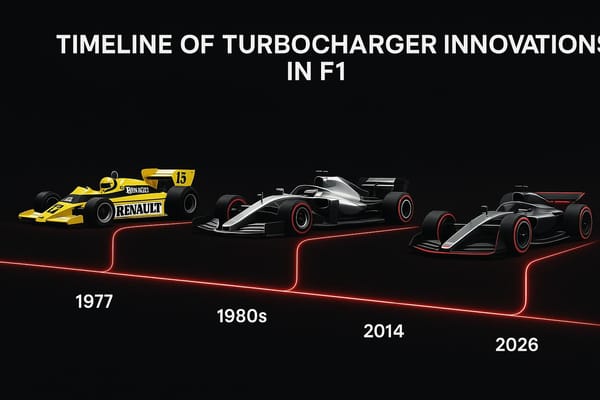Sustainability in F1 Logistics
Explore how a major motorsport is reducing its carbon footprint through innovative logistics and renewable energy solutions.

Formula 1 is tackling one of its biggest challenges: reducing its carbon emissions from global logistics. From transporting cars and equipment to powering race venues, F1’s operations have historically left a large carbon footprint. Now, the sport is implementing cleaner fuels, smarter planning, and renewable energy solutions to achieve its ambitious goal of net-zero emissions by 2030. Here’s how F1 is making it happen:
- Cleaner Fuels: Freight trucks now use biofuels like HVO100, and air transport incorporates Sustainable Aviation Fuel (SAF) to cut emissions significantly.
- Smarter Planning: AI-powered route optimization reduces fuel use and delays, while sea freight is prioritized for heavier equipment to minimize emissions.
- Renewable Energy at Venues: Race paddocks and pit lanes are powered by centralized low-carbon systems, combining biofuel generators, solar panels, and battery storage.
- Impact: European venues have reduced emissions by 90%, and logistics improvements cut emissions by thousands of tons annually.
F1’s efforts not only aim to transform motorsport logistics but also offer scalable solutions for other industries looking to reduce their environmental impact.
Sustainability in Formula 1 - Is F1 focusing on the wrong thing?

Green Technology in F1 Transport
Formula 1's commitment to achieving net-zero emissions is driving significant changes in its transport operations. By embracing greener technologies, F1 is proving that sustainability can go hand in hand with high-performance logistics. These efforts focus on reducing emissions in one of the sport's most challenging areas: transport.
Biofuel Truck Operations
F1 has started using HVO100 biofuel to power its freight trucks. This fuel is made from waste materials like used cooking oil, animal fats, and vegetable oil residues. Initial trials show that HVO100 can deliver substantial carbon emission reductions without sacrificing performance. To ensure this solution is practical on a larger scale, stakeholders are working to secure dependable fuel supplies at key locations. Meanwhile, similar efforts are underway to address emissions in air transport.
Sustainable Aviation Fuel (SAF) Usage
Air transport plays a major role in F1's carbon footprint, which has led to the adoption of Sustainable Aviation Fuel (SAF). SAF is produced from renewable sources like waste oils and agricultural residues and can significantly lower lifecycle carbon emissions compared to traditional jet fuel. By blending SAF with conventional jet fuel, F1 teams are reducing emissions for long-haul, intercontinental shipments. Dedicated SAF supplies are being secured to ensure consistent availability for these flights.
Digital Route Planning Systems
Cutting-edge digital tools are also helping F1 optimize its global transport operations. AI-powered route planning systems now use real-time data - such as GPS, weather conditions, traffic updates, and fuel metrics - to find the most efficient routes. These systems can adapt on the fly, taking customs procedures and port congestion into account to avoid delays and reduce unnecessary fuel use. Additionally, IoT sensors combined with machine learning further enhance operational efficiency while supporting sustainability goals.
Renewable Energy at Race Venues
Formula 1’s commitment to achieving net-zero emissions isn’t just about how teams and equipment travel; it’s also about how race venues themselves are powered. The organization is moving away from traditional diesel generators, embracing renewable energy solutions to significantly cut the carbon footprint of race weekends. By doing so, F1 is setting a precedent for more efficient and sustainable energy systems that enhance race operations.
Centralized Power Generation Systems
European race venues now rely on centralized, low-carbon energy systems instead of the old model where each team operated its own generator. These unified systems streamline paddock energy needs while drastically reducing emissions.
F1’s energy partner, Aggreko, leads the charge with systems that combine multiple renewable technologies. These include hydrotreated vegetable oil (HVO)-fueled generators, solar panels, and battery energy storage systems (BESS). Together, these technologies power everything from pit lane activities to event control centers, ensuring reliable renewable energy throughout the race weekend.
After successful trials at the 2023 Austrian Grand Prix and subsequent implementations at the 2024 Hungarian and Italian events, all nine European races in 2025 adopted this system. A prime example is the Emilia-Romagna Grand Prix at Imola, held in May 2025.
Currently, 80% of race promoters are using alternative energy sources such as solar panels, biofuels, and green energy tariffs. There are plans for the remaining venues to transition to similar renewable technologies in the near future.
Measured Carbon Emission Reductions
The impact of these renewable energy initiatives is already evident. The centralized low-carbon energy systems are expected to reduce carbon emissions by around 90% at European race paddocks - a major milestone in F1’s sustainability efforts.
Additionally, emissions from event operations have already dropped by 12% per race due to the shift to renewable energy sources. These reductions highlight how F1’s strategic approach to sustainability can deliver meaningful environmental benefits without affecting the quality of operations.
"We remain on track to be Net Zero by 2030, and it is innovations such as this that will see us hit our goal." – Ellen Jones, Head of ESG, Formula 1
Considering the scale of F1 race weekends - with their demands for timing systems, broadcasting, hospitality, and team operations - achieving a 90% reduction in emissions while maintaining performance standards is a testament to the effectiveness of renewable energy solutions in even the most demanding environments.
Logistics Partnerships and Transport Methods
As Formula 1 embraces renewable energy at race venues, its logistics innovations are also playing a big role in reducing the sport's environmental footprint. By combining smart partnerships and diverse transport methods, F1 is pushing forward on its sustainability journey.
Key Logistics Partnerships
DHL, Formula 1's official logistics partner, is at the forefront of these efforts. They’re working on integrating sustainable fuel options for truck transport and optimizing shipping routes to cut down on emissions. Using advanced analytics, DHL identifies the most efficient routes while meeting the championship’s tight schedules. This data-driven approach ensures that F1 logistics are not only fast but also environmentally conscious.
Beyond DHL, F1 collaborates with other partners to expand its transport options. These partnerships provide flexibility, allowing the sport to adapt transport methods based on timing and environmental priorities.
Combined Transport Solutions
Formula 1 uses a mix of transport methods - sea freight, road transport, and air cargo - to balance operational needs with sustainability goals. Here’s how it works:
- Sea freight handles heavy equipment for flyaway races, offering lower emissions per ton compared to other methods.
- Biofuel trucks are used for European routes, relying on sustainable fuels to reduce emissions.
- Air cargo is reserved for urgent, time-sensitive items but comes with a higher environmental cost.
| Transport Method | Primary Use | Emission Impact |
|---|---|---|
| Sea Freight | Heavy equipment for flyaway races | Lower emissions per ton |
| Biofuel Trucks | European race logistics | Reduced emissions with sustainable fuels |
| Air Cargo | Urgent, time-sensitive items | Higher emissions |
This multimodal strategy is carefully coordinated to ensure reliability without compromising environmental goals. Each transport method is backed by contingency plans to maintain sustainability standards, even when adjustments are necessary. Advanced route optimization technology also plays a key role, analyzing fuel consumption, emissions, and transit times to determine the best combinations for each race. This ensures F1 continues to meet its operational demands while steadily lowering its environmental impact.
Future Impact on Motorsports and Industry
F1's push for greener logistics could set new standards across industries. By refining its operational strategies in high-pressure, high-performance settings, F1 is poised to influence commercial transportation and logistics practices well beyond the racetrack. These efforts amplify the sport's commitment to sustainability.
Advanced Fuel Development
One area of focus is the development of sustainable fuels like biofuels and sustainable aviation fuels (SAF). These fuels are designed to maintain high performance while slashing carbon emissions. The cutting-edge technologies tested and perfected in F1 could serve as a roadmap for integrating sustainable fuels into broader commercial applications.
Broader Industry Applications
F1's innovations go beyond fuel. For instance, its advanced digital tools for route optimization help reduce fuel consumption and make operations more efficient. These scalable solutions offer a practical model for improving logistics sustainability across various industries.
Conclusion: F1's Green Logistics Progress
Formula 1 has made impressive strides in reshaping its logistics to be more environmentally friendly, achieving tangible results that ripple far beyond the track. By embracing sustainable practices, the sport is showing that even high-performance industries can adopt greener methods without sacrificing efficiency.
The numbers speak volumes: in 2024, F1 partnered with DHL and Qatar Airways to invest in Sustainable Aviation Fuel (SAF), cutting emissions by more than 8,000 tCO₂e - a reduction of around 19% compared to traditional aviation fuel for flyaway events. This is a crucial achievement, especially since the bulk of F1's carbon footprint comes from off-track logistics, while the race cars themselves contribute only about 1% of total emissions.
In addition, F1 tested low-carbon energy systems at three major European venues in 2024 - the Red Bull Ring, Hungarian GP, and Italian GP in Monza. These systems are designed to slash emissions by over 90% in key areas like the Paddock and Pit Lane, with plans to expand their use across all European Grands Prix by 2025.
Beyond technical advancements, F1's initiatives have inspired broader changes within the motorsports community. In 2024, over 80% of race promoters powered their events with alternative energy sources, while more than 90% introduced greener travel options for fans. This collective shift underscores how F1's sustainability efforts are driving meaningful change across the industry.
With its sights set on achieving net-zero carbon emissions by 2030, F1 is proving that environmental responsibility can coexist with elite competition. The innovations born from F1's rigorous demands are already influencing commercial logistics and transportation, positioning the sport as a leader in sustainability. By continuously refining its green logistics, F1 is setting a new standard for sustainability in global sports.
FAQs
How does Formula 1 ensure biofuels like HVO100 and Sustainable Aviation Fuel (SAF) are reliable for logistics operations?
Formula 1 is taking significant steps to ensure the dependability of biofuels like HVO100 and SAF by working closely with biofuel producers and logistics partners. As part of this initiative, logistics providers have upgraded their fleets to include vehicles that run on eco-friendly fuels, aligning with F1's push for more sustainable transportation options.
On top of that, F1 is actively investing in the development of sustainable fuels made from renewable resources, such as agricultural waste and used cooking oil. This is all part of their ambitious plan to transition to 100% sustainable fuel use by 2026, aiming to ensure a steady supply while maintaining compatibility with current infrastructure. These efforts not only help cut emissions but also highlight F1's dedication to greener and more efficient logistics.
How does DHL help Formula 1 reduce carbon emissions in its logistics operations?
DHL is making a meaningful impact on Formula 1's carbon footprint by incorporating biofuel-powered trucks for transporting equipment during European races. These trucks significantly reduce emissions - by as much as 83% - when compared to traditional diesel-powered vehicles. On top of that, DHL employs sustainable aviation fuel (SAF) for air freight, slashing flight-related emissions by around 80%.
These initiatives align closely with Formula 1's ambitious target of reaching net-zero carbon emissions by 2030. By combining innovative logistics with sustainability, DHL ensures the sport's high-speed demands are met without compromising environmental responsibility.
How can F1's innovations in renewable energy and logistics inspire sustainability in other industries?
Formula 1's efforts to embrace greener practices, such as incorporating biofuels, solar power, and battery technologies, serve as a model for industries aiming to minimize their environmental footprint. By streamlining freight logistics and shifting to renewable energy in their operations, F1 showcases how large-scale industries can achieve efficiency while prioritizing environmental care.
These initiatives provide real-world examples of actionable and scalable strategies that other sectors can adopt to cut carbon emissions and move closer to net-zero targets, encouraging innovation and teamwork across industries to support global environmental goals.




